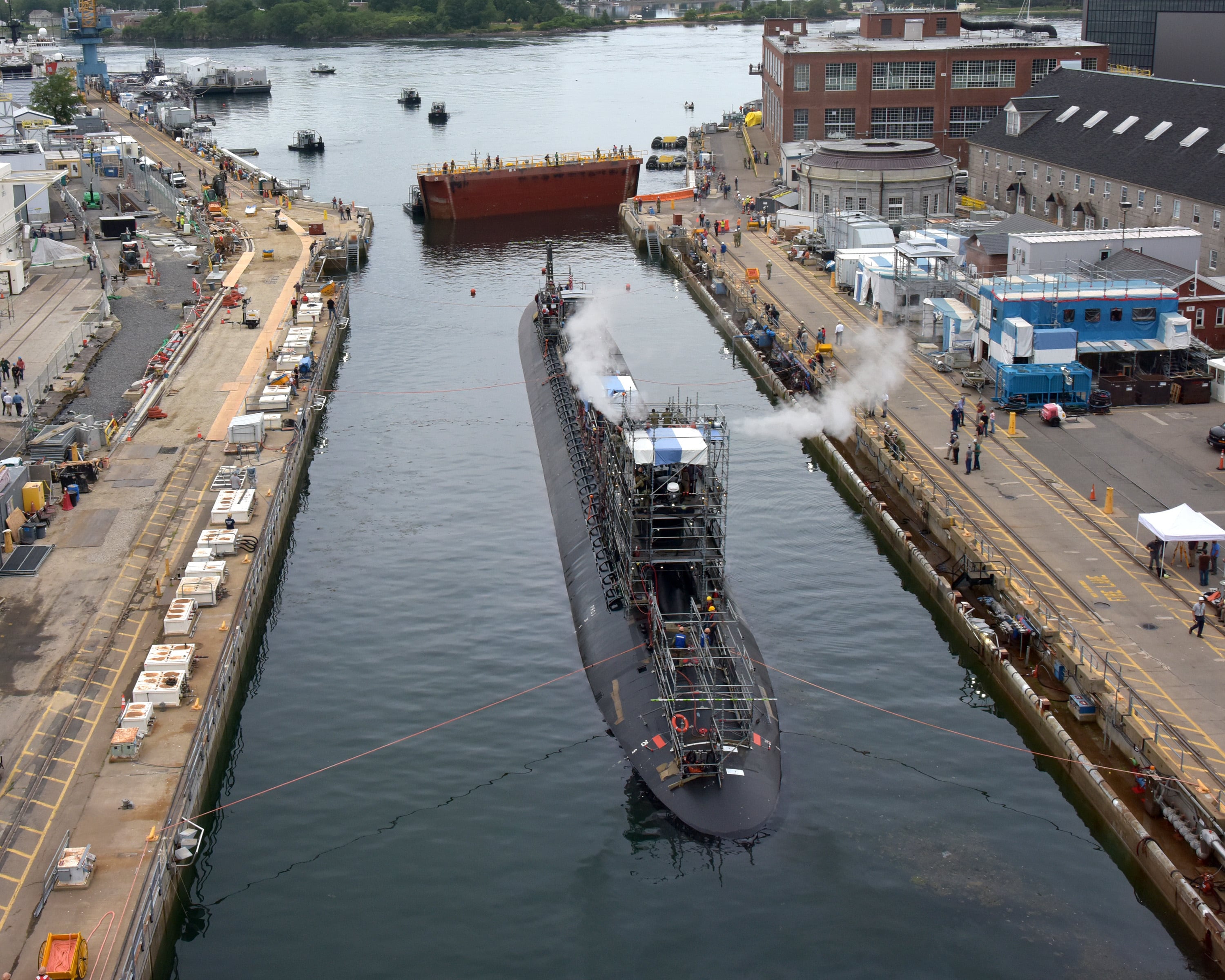VIRGINIA BEACH, Va. — The submarine industrial base, already strained by demand for new construction, may need to accelerate its production of spare parts to alleviate submarine maintenance woes.
The vast majority of submarine maintenance availabilities run late, in part due to poor planning practices and in part because repair yards rely on a pool of replacement parts “that just doesn’t exist” after the Navy failed to sufficiently prepare for Virginia-class submarine sustainment, according to two admirals.
“That upfront investment didn’t happen for Virginia-class, so we’re missing that whole sustainment tail, or a big portion of that,” Rear Adm. Scott Brown, the deputy commander of Naval Sea Systems Command for industrial operations (NAVSEA 04), said Sept. 20 at the American Society of Naval Engineers’ annual Fleet Maintenance and Modernization Symposium here.
“It’s resulting in a lot of churn, a lot of cannibalization — so we have to take things off other boats to stick them on the boat we’re trying to get out — and a lot of, frankly, frustration with the workforce on waiting for stuff that doesn’t exist,” he added. “Of course, that leads to delays.”
He said the Navy asked the Center for Naval Analyses to study the connection between material delays and extended maintenance availabilities; the research organization found the lack of material on hand “is a fairly large contribution to our delays,” according to Brown.
Vice Adm. Bill Galinis, the commander of NAVSEA, said Sept. 21 at the same conference that only 20% to 30% of submarine maintenance availabilities over the last decade have finished on time. The problem is worsening as the Virginia-class submarines account for a greater percentage of the undersea fleet, he said.
“We’ve seen a significant growth in the amount of man days required to complete a submarine availability, particularly a Virginia-class one, and [we’re] really trying to deep-dive and understand why that really is,” Galinis added.
He pointed to a couple potential factors. For parts purchased with annual operations and maintenance funding, global supply chain issues mean it takes longer for parts to be delivered. In some cases, it’s taking up to two years, putting current and upcoming availabilities at risk.
For spare parts managed through the Defense Logistics Agency or the Naval Supply Systems Command, the Navy has only funded some of these at about 40% or 50% in recent years. As a result, parts simply aren’t in the inventory when needed by the Navy’s four public shipyards.
And, Galinis added, the rotable pool of spares is too small due to a lack of investment in the early years of the Virginia-class acquisition. The rotable pool is made up of parts taken off a submarine by shipyard workers and later refurbished for use in the future.
He added that the refurbishment process is moving too slowly, meaning parts aren’t available when needed. Galinis said the Navy may have to contract out some of that refurbishment work.
Brown told Defense News his office, which oversees the work of all four public shipyards, wants to increase the inventory of each component in the rotable pool and also add new types of components that have particularly blocked the service from completing maintenance availabilities on time.
Brown said he doesn’t expect the problem to cost the Navy more, but the service may need to spend more quickly on spares and sustainment.
“That’s going to cause a push of material dollars to the left in the [five-year Future Years Defense Program] to buy early to make sure we have that stuff. But it’s eventually going to equalize out, because we’re going to end up buying it anyway,” he said.
Galinis also pointed to a lack of rigor in submarine planning and project management, which he said is exacerbating the maintenance delays.
A number of pre-availability assessments and tests must take place on all submarines, aircraft carriers and surface ships to help identify the exact condition of the ship and what work is needed.
“The submarine force is probably the hardest one for us to get that done, principally because of their operational schedule and just in some cases the difficulty getting teams out to a submarine,” Galinis said. But it means some planning documents aren’t completed until the submarine is back in port, generating additional delays.
Indeed, whereas surface ships only see about 10% so-called unplanned work, aircraft carriers have been seeing a 22% unplanned work rate and submarines are nearing 30%, the NAVSEA commander said.
Though submarine maintenance faces a slew of challenges, Galinis said aircraft carrier maintenance is improving. The four public shipyards — all of which work on submarines and two of which work on aircraft carriers — have actually seen fewer maintenance delays in recent years. In fiscal 2019, he said, the four yards totaled 1,500 delay days. In FY 22, that’s down to about 1,100, a 27% decrease.
Additionally, Galinis said, 13 of the last 18 aircraft carrier maintenance availabilities have finished on time or early, with the late ones largely related to carriers that conducted back-to-back deployments and skipped a maintenance period in between.
“I credit that [higher on-time completion rate] to the work that the larger team has done on the planning process,” he said. “The planning efforts on the carrier side are probably the most stable” compared to surface ships and submarines.
Megan Eckstein is the naval warfare reporter at Defense News. She has covered military news since 2009, with a focus on U.S. Navy and Marine Corps operations, acquisition programs and budgets. She has reported from four geographic fleets and is happiest when she’s filing stories from a ship. Megan is a University of Maryland alumna.





